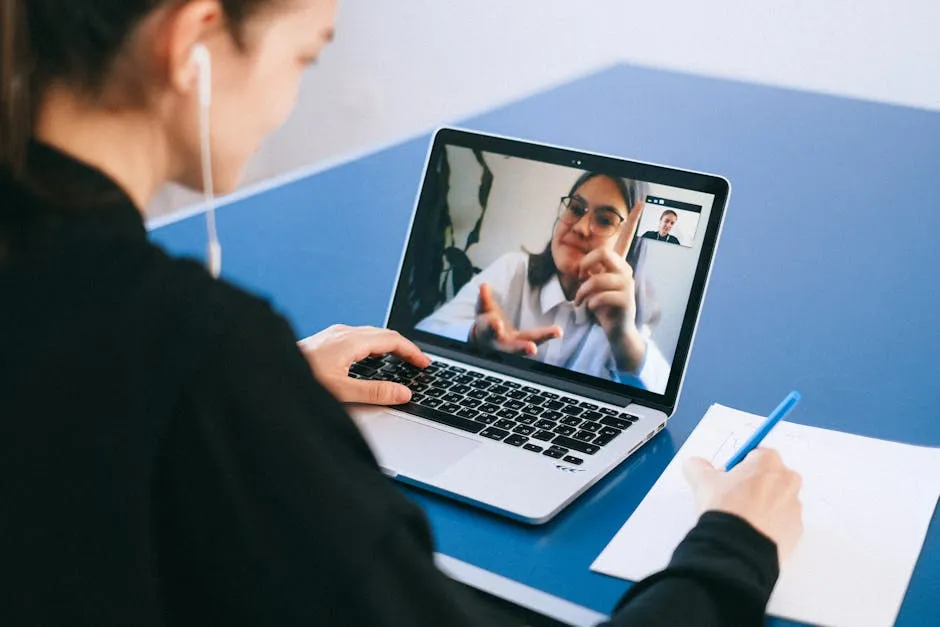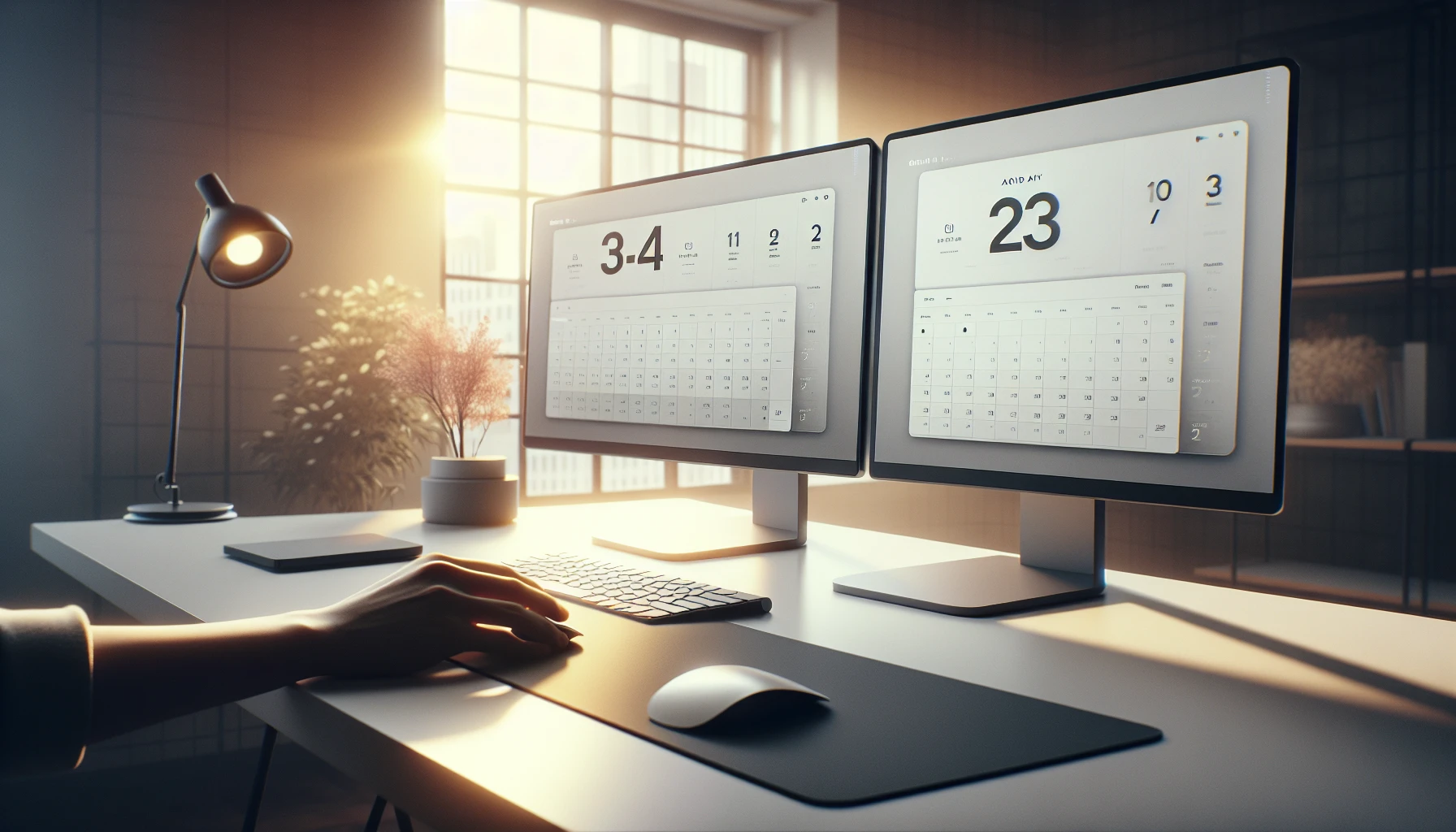· Ricardo Batista · 14 min read
Optimize Google Meet with Breakout Rooms Tips
Explore how to effectively use Google Meet Breakout Rooms to enhance

Google Meet Breakout Rooms provide a lively approach to boost cooperation & involvement during virtual gatherings. By separating attendees into smaller groups, Breakout Rooms enable concentrated discussions & teamwork, rendering large meetings more interactive & productive. In this piece, we’ll investigate how to efficiently utilize Breakout Rooms in Google Meet to optimize your online meeting experience.
Key Takeaways
- Breakout Spaces in Google Gather permit leaders to split attendees into tinier bunches for concentrated talks or doings.
- Breakout Spaces could improve teamwork, participation, & interaction in online gatherings, making them more fruitful & interactive.
Introduction to Google Meet Breakout Rooms
What are Breakout Rooms?
Breakout Spaces in Google Meet are a capability that permits meeting leaders to divide attendees into smaller bunches for more concentrated discussions or tasks. This is particularly handy in educational environments, workshops, or any circumstance where smaller group interactions can boost the overall meeting experience. Breakout Spaces can be generated & handled by the meeting leader, who can transition between rooms to oversee progress & offer aid as required.
To create Breakout Rooms in Google Meet, follow these steps:
- Start a Google Meet session: Begin by starting or joining a Google Meet session.
- Get into Breakout Rooms: Tap on the “Stuff” symbol in the upper right side of the display, then pick “Breakout rooms”.
- Organize Separate Spaces: Pick the quantity of areas you wish to make. You can manually allocate attendees to every space or permit Google Meet to do it randomly.
- Open Breakout Rooms: Once the rooms are set up, click “Open rooms” to start the breakout sessions.
For more detailed instructions, you can refer to the Google Meet Help Center.
Benefits of Using Breakout Rooms
Breakout Rooms offer several benefits that can significantly enhance the effectiveness of your meetings:
- Improved Teamwork: Tinier teams permit closer and concentrated talks, simplifying the sharing of thoughts & cooperating smoothly.
- Boosted Involvement: Breakout Areas could make bigger gatherings more engaging by providing everybody an opportunity to take part actively.
- Customized Education: In school environments, Breakout Areas permit instructors to offer extra individualized focus & tackle particular learning requirements.
- Productive Issue-Resolving: Groups are able to work on various parts of an issue at the same time, making the overall issue-resolving process more productive.
To guarantee participants show up on time & stay involved, think about utilizing Meeting Reminders. This program mechanically notifies latecomers, saving you the trouble of manually sending reminder messages. Just set up the Google add-on in your Google Calendar, & let Meeting Reminders take care of everything else.
For more tips on managing your Google Meet sessions effectively, check out our article on how Google Meets work.
Setting Up Breakout Rooms in Google Meet
Requirements and Eligibility
- Google Workspace for Education
- Google Workspace Business Standard
- Google Workspace Business Plus
- Google Workspace Enterprise Essentials, Standard, and Plus
Moreover, the gathering organizer needs to utilize a PC to make & deal with Breakout Rooms, since this element isn’t accessible on versatile gadgets. Members can join Breakout Rooms from any gadget, however the host should start the arrangement from a work area or PC.
Step-by-Step Guide to Creating Breakout Rooms
• Making Breakout Spaces in Google Meet is a simple process. Follow these instructions to establish & handle Breakout Spaces properly:
Commence or Participate in a Google Meet Session: Initiate by starting or joining a Google Meet session. Make certain you are the meeting host to gain access to the Breakout Rooms feature.
Get the Breakout Rooms Feature: Tap on the “Stuff” symbol situated in the upper right side of the screen. From the menu that appears, choose “Breakout rooms.”
Set Up Breakout Rooms:
- Quantity of Spaces: Pick the amount of Breakout Areas you desire to make. You’re able to generate up to 100 Breakout Areas in one gathering.
- Allocate Attendees: You are able to manually allocate attendees to every chamber or permit Google Meet to automatically spread them out. To manually allocate, drag & drop attendees’ names into the desired chambers.
Alter Space Arrangements: Optionally, you could rename the Breakout Areas to mirror the discussion subjects or group titles. This could assist attendees in effortlessly recognizing their allocated spaces.
Initiate Breakout Areas: After you’ve arranged the spaces & allocated attendees, tap “Launch rooms” to commence the breakout gatherings. Participants will get a notification & be instantly transferred to their designated areas.
Oversee & Handle Spaces: Being the organizer, you are able to shift amongst Breakout Areas to supervise conversations & offer help. You could also transmit messages to every space or end the spaces when the breakout sessions finish.
For more detailed instructions, you can refer to the Google Meet Help Center.
To guarantee participants arrive promptly & stay attentive, think about utilizing Meeting Reminders. This program mechanically notifies latecomers, sparing you the trouble of manually transmitting reminder messages. Just set up the Google extension within your Google Calendar, & let Meeting Reminders take care of everything else.
For additional tips on managing your Google Meet sessions effectively, check out our article on how Google Meets work.
Managing Breakout Rooms
Assigning Participants
Allocating attendees to Breakout Spaces in Google Meet could be accomplished either by hand or mechanically. Here’s how you might oversee this procedure:
- Get into Breakout Spaces: Throughout your Google Meet gathering, tap on the “Stuff” symbol in the upper right corner & pick “Breakout spaces.”
- Choose the Number of Rooms: Decide how many Breakout Rooms you need. You can create up to 100 rooms.
- Allocate Attendees Randomly: If you’d rather have an automatic distribution, Google Meet will spread participants equally across the spaces. Simply click “Mix” to randomize the allocations.
- Allocate Attendees By Hand: For manual distribution, drag & drop participants’ names into the desired spaces. This permits you to assemble attendees founded on particular standards, like project squads or discussion subjects.
Using Meeting Reminders can guarantee that every participant is there & punctual. This tool mechanically notifies latecomers, saving you the trouble of manually sending reminder emails. Just install the Google add-on in your Google Calendar, & let Meeting Reminders take care of the remaining tasks.
Monitoring and Assisting Participants
Once Breakout Rooms are established & participants assigned, it’s vital to supervise & help them to guarantee fruitful conversations. Here’s how you could accomplish it:
- Commence Breakout Areas: Tap “Launch rooms” to begin the breakout meetings. Attendees will get a notification & be transferred to their respective spaces.
- Switch Between Spaces: As the leader, you can join any Breakout Area to oversee the talks & provide help. Click the “Actions” symbol, choose “Breakout areas,” then click “Join” beside the area you wish to enter.
- Spread Messages: To chat with all people at the same time, utilize the broadcast quality. Click the “Activities” symbol, pick “Breakout rooms,” then click “Broadcast message.” Type your message & send it to all rooms.
- Shut Down Breakout Areas: When the split-up meetings finish, click “End rooms” to get all people back to the main gathering. You can additionally set a timer for the breakout meetings to automatically close after a certain time period.
For more tips on managing your Google Meet sessions effectively, check out our article on how to share your screen on Google Meets.
Utilizing these techniques, you can guarantee that your Breakout Areas are properly arranged & that attendees stay involved & fruitful all through the meeting.
Advanced Features and Tips
Using Timers and Countdown
Here’s the modified version of the content, following the instructions provided:
- Get into Breakout Spaces: Throughout your Google Meet gathering, tap on the “Stuff” symbol in the upper right corner & pick “Breakout spaces.”
- Set Up Breakout Rooms: Create the desired number of Breakout Rooms and assign participants as needed.
- Establish a Timekeeper: Prior to commencing the breakout rooms, you have the capability to designate a duration for the breakout sessions. Click the “Establish Timekeeper” choice & pick the length for the breakout sessions. This will automatically inform attendees when the allotted time has elapsed & return them to the principal gathering.
- Commence the Countdown: After the duration is established, click “Unlock spaces” to initiate the breakout gatherings. The timer will start decreasing, & attendees will receive a notification when the period is nearly concluded.
Utilizing clocks guarantees that conversations remain concentrated & that all assemblies have equivalent opportunity to add. For additional pointers on overseeing your Google Meet meetings adequately, look at our article on how to impart your screen on Google Meets.
Broadcasting Messages to All Rooms
Broadcasting messages to all Breakout Rooms is a handy tool for sharing crucial details or directions to all attendees at once. Here’s the way you can broadcast messages:
- Get into Breakout Spaces: Throughout your Google Meet gathering, click the “Stuff” symbol at the upper right and pick “Breakout areas.”
- Open Breakout Rooms: Set up and open the Breakout Rooms as needed.
- Spread a Note: To transmit a memo to all chambers, tap on the “Happenings” symbol, pick “Breakout chambers,” & then click “Broadcast memo.” Type your memo in the text area & click “Send.” All attendees in the Breakout Chambers will get the memo.
Broadcasting messages is an efficient technique to offer updates, distribute materials, or provide directions without disrupting the progression of the breakout sessions.
To guarantee participants show up on time & stay involved, think about utilizing Meeting Reminders. This program mechanically notifies latecomers, saving you the trouble of manually sending reminder messages. Just set up the Google add-on in your Google Calendar, & let Meeting Reminders take care of everything else.
For additional tips on managing your Google Meet sessions effectively, check out our article on how Google Meets work.
Utilizing these sophisticated capabilities & recommendations, you’re able to boost the efficiency of your Breakout Rooms & guarantee a seamless & fruitful meeting encounter.
Troubleshooting Common Issues
Common Problems and Solutions
• Utilizing Breakout Rooms in Google Meet can occasionally pose difficulties. Here are some frequent issues & their resolutions:
- Participants Can’t Join Breakout Rooms:
- Solution: Make certain participants utilize the newest edition of Google Meet & they’re on a supported gadget. If the problem continues, attempt reassigning the participants to the rooms or restarting the Breakout Rooms.
- Audio or Video Issues in Breakout Rooms:
- Solution: Examine the attendees’ web link & request they renew their web browser. Guarantee their mic & camera permissions are enabled in the browser configs. For more in-depth troubleshooting, refer to our post on Google Meets connection problems.
- Breakout Rooms Not Available:
- Solution: Check that you’re utilizing a Google Workspace version enabling Breakout Rooms. Make certain you’re the meeting organizer & accessing Google Meet via a computer, as Breakout Rooms can’t be made from mobile gadgets.
- Participants Not Receiving Broadcast Messages:
- Solution: Make certain you’re utilizing the broadcast characteristic appropriately. Tap on the “Activities” symbol, pick “Breakout rooms,” then click “Broadcast message.” Type your message & send it to every room. If the problem continues, request participants to inspect their chat notifications.
To guarantee participants show up on time & stay involved, think about utilizing Meeting Reminders. This program mechanically notifies latecomers, saving you the trouble of manually transmitting reminder messages. Just set up the Google add-on within your Google Calendar, & let Meeting Reminders take care of everything else.
Where to Get Help
If you encounter issues that you cannot resolve, there are several resources available to help you:
Google Meet Help Center: The Google Meet Help Center provides comprehensive guides and troubleshooting tips for common issues.
Google Workspace Support: If you are a Google Workspace user, you can contact Google Workspace Support for personalized assistance.
Community Forums: Interact with different people & specialists in the Google Meet Community Forum. You can inquire queries, exchange encounters, & discover fixes to widespread issues.
Gathering Notifications Aid: For difficulties connected to gathering alerts & participant involvement, go to the Gathering Alerts support webpage for help.
For additional tips on managing your Google Meet sessions effectively, check out our article on how to share your screen on Google Meets.
Utilizing these tools, you can rapidly fix any problems & guarantee a seamless & fruitful meeting experience.
Best Practices for Using Breakout Rooms
Effective Use Cases
Breakout Rooms in Google Meet could be very useful in different situations. Here are some examples where Breakout Rooms might improve the meeting:
- Learning Environments: Instructors could utilize Breakout Areas to encourage group conversations, peer assessments, & cooperative undertakings. This enables learners to interact more thoroughly with the subject matter and with one another.
- Workshops & Training: Breakout Rooms could be utilized to split participants into smaller groups for practical activities, role-playing, or idea-generating sessions. This makes the workshop more participatory & captivating.
- Group Gatherings: In business environments, Breakout Areas could be utilized for team-bonding activities, project preparation, & troubleshooting discussions. Smaller teams can concentrate on particular assignments and then report back to the bigger crew.
- Networking Happenings: Breakout Areas could help networking by letting people have more close talks in smaller bunches. This is really handy in online meetings and get-togethers.
Tips for Facilitators
To make the most out of Breakout Rooms, facilitators should follow these best practices:
- Straightforward Directions: Prior to launching Breakout Spaces, give uncomplicated guidelines regarding the activities or conversations to be carried out. This guarantees participants comprehend what’s anticipated from them.
- Utilize a Timekeeper: Employ the timer capability to maintain discussions progressing smoothly. This aids in guaranteeing that every group has an equal chance to contribute & that the gathering remains on schedule.
- Observe Advancement: Shift amongst Breakout Areas to watch over progression & offer aid when required. This assists in keeping attendees concentrated & guarantees that dialogues are fruitful.
- Transmit Messages: Utilize the broadcast capability to convey crucial updates or directions to all spaces concurrently. This is advantageous for maintaining everyone aligned.
- Utilize Gathering Alerts: To guarantee that participants are timely & involved, think about utilizing Meeting Reminders. This tool mechanically notifies attendees when they’re tardy, sparing you the trouble of physically sending reminder messages. Simply set up the Google add-on in your Google Calendar, & let Meeting Reminders take care of the remainder.
For additional tips on managing your Google Meet sessions effectively, check out our article on how to share your screen on Google Meets.
By adhering to these optimal strategies, coordinators can guarantee that Breakout Spaces are utilized proficiently, resulting in more captivating & fruitful gatherings.
Conclusion
To summarize, becoming skilled at utilizing Google Meets Breakout Rooms feature can greatly improve the quality of online gatherings by encouraging teamwork, involvement, & interaction between attendees. By properly utilizing Breakout Rooms, meeting organizers are able to create a more lively & productive meeting atmosphere, particularly in educational settings, workshops, or team-building activities. Comprehending the setup procedure, managing participants, taking advantage of advanced capabilities like timers, & resolving common issues are crucial aspects for ensuring a smooth experience with Breakout Rooms in Google Meet. By following best practices & exploring the full potential of Breakout Rooms, users can transform their virtual meetings into engaging & interactive sessions that foster meaningful discussions & outcomes.
Frequently Asked Questions (FAQs)
How do I enable Breakout Rooms in Google Meet?
To allow Breakout Rooms in Google Meet, you must be the host of the gathering. After you begin the meeting, click the “Activities” symbol at the bottom of the screen & choose “Breakout Rooms.” From that point, you can establish and oversee the Breakout Rooms for your meeting.
Can participants join Breakout Rooms on their own in Google Meet?
In Google Meet, attendees cannot enter Breakout Rooms independently. The host or co-hosts must allocate participants to particular Breakout Rooms by hand or automatically.
Are Breakout Rooms available in all Google Meet editions?
Breakout Spaces in Google Meet are accessible for particular Google Workspace versions. It’s crucial to inspect the precise edition you’re utilizing to figure out if Breakout Spaces are a component incorporated in your strategy.
How many Breakout Rooms can I create in Google Meet?
The quantity of Breakout Spaces you can make in Google Meet relies upon the version of Google Workspace you’re utilizing. Certain editions permit a restricted number of Breakout Spaces, while others might have higher limits. Check your plan for additional information.
Can I record Breakout Room sessions in Google Meet?
As of the newest update, Google Meet doesn’t possess an integrated capability to capture Breakout Room discussions. If you require recording the conversations occurring in Breakout Rooms, you might contemplate utilizing external recording instruments or screen capturing applications.



